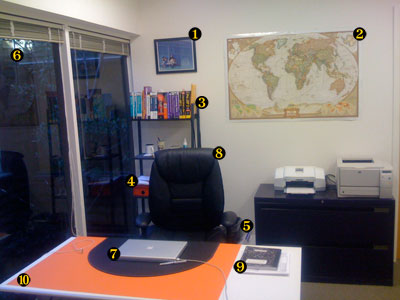I’m re-reading Tom Peters’ Talent. It’s funnyânot the ‘ha-ha’ type but the ‘strange’ type of funnyâthat on a second reading, the material often takes on an entirely different cast. I believe it’s the time in between the readings, the between time, in which your daily experiences are interpreted within the context of ideas gleaned from the first reading.
In any event, Peters accomplishes at least one of his goals:
“I don’t expect you’ll agree with everthing that I say in this book. But I hope that when you disagree ⦠you will disagree angrily. That you will be so pissed off that you’ll ⦠Do Something.” [p.9]
And he accomplishes it. I do not agree with everthing he writes in Talent. And if you really engage what he has to say, it will piss you off. It will challenge your personal view of the world and, more importantly, your view of yourself. Just who the hell are you and who cares?
Peters has a short questionaire he uses in his consulting practice. Seven sentence completion exercises. [pp.46-47]
1. I am known forâ¦
2. Next year at this time I will also be known forâ¦
3. My current project is challenging me in these waysâ¦
4. New things I’ve learned in the last 90 days includeâ¦
5. My public “recognition program” consists ofâ¦
6. Additions to my Rolodex in the last 90 days includeâ¦
7. My resume today is Discernibly Different from my resume last year at this time in these waysâ¦
The first time I read this, it struck me as both obvious and seldom considered. I made a mental note that I should do this exercise periodically. Yeah. Didn’t happen.
What did happened inside the two years since I first read Talent is I interviewed a lot of applicants for positions at the startup I’m withâa LOT of applicants.
There comes a pointâand it’s different for everyoneâwhen while you’re interviewing a guy who wanders endlessly in verbal brownian motion ⦠at that point, you scream quietly inside your mind, “Dammit, Man! Get it together!”.
I mean, come on! The job description was typed out, published online, described verbally by the recruiter, bla bla bla. If you’re not prepared (or willing) to present how you can take on the job as described, at least be prepared to present how you can do something relevant to the company’s business.
Once that happens to you, once you snap, you start to see it EVERYWHERE. In training. In meetings. In the myriad daily conversations with co-workers.
It hit me this week. How prepared am I to interview? What the hell have I done this last year?
Let me tell you. This may not be going where you think. I am not setting out to interview. I’m not done with my current gig.
It hit me this week. I don’t have time to play with D players. I don’t have time for even the B players. I want to play with the A players. I’ve been too damn tolerant for too damn long. And the words that rang in my ears were, again, Peters’:
“FACT: Some people are more talented than other people.”
“FACT: Some people are a hell of lot more talented than other people.”
“Talent matters.”[p.14]
Hell yes, it matters. Either you’re on the A-List or you’re not. Either you areâand this is hardâeither you are on the A-Team or you’re not.
Why is that hard? Because you work with these people. You develop relationships with them. You become connected. If you accommodate their D-Listedness then you become unwilling to hold them to A-List performance. And that unwillingness leaves you resigned to the D-Listedness. In the end, you have all the rationalizations, explanations and justifications as to why that’s the best that could have been done. None of that changes the fact that you are on the B-Team. None of that changes the fact that A-List players don’t play on the B-Team.
So, what do you do? How do you start?
Well, don’t go out and start interviewing. You’ll just end up on the same team. Just different players. A-Listedness starts with you.
You look into the mirror and you say, “Dammit, man! Get it together!”
